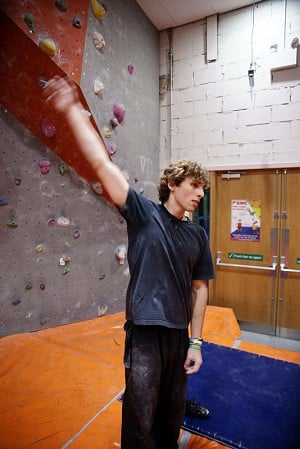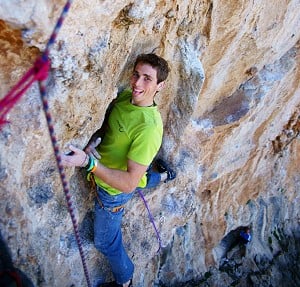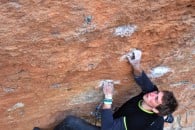How to 'Warm Up' for Climbing
In this short pre-cursor to his main series, Robbie takes us through a 'warm up' and 'cool down' routine to help with our climbing and training sessions.

Warming Up (It's cool to warm up!)
We all know that you need to warm up before doing exercise, but how many of us actually do? In climbing, we are putting a lot of strain on to tiny ligaments and tendons not designed to carry the weight of our bodies. Over time our muscles and tendons adapt to the strain and become more capable of withstanding the pressure we put on them, but this is no excuse not to warm up.
Before my session begins, I always start by raising my heart rate. This is to get blood quickly to the muscles and prepare them for intense activity. If we don't do this, our muscles will be cold and more likely to tear under strain.
To raise the heart rate, five minutes of aerobic activity such as running, skipping or cycling is enough.
The second stage of the warm up is stretching. I like to stretch dynamically before climbing, this promotes the secretion of synovial fluid into the joints, thereby lubricating and preparing them for intense activity (your biology lesson for the day).
Here is an example of a dynamic stretching routine:
- Neck – Move your head gently from side to side and forwards and backwards (5 reps each)
- Shoulders – Roll your shoulders forward and backwards (10 reps each)
- Shoulders (2) – Roll your arms round in circles (like a windmill) changing the direction for a second set as well (10 reps each side)
- Hips – Create hip circles as if you're a 70's disco diva (10 reps each side)
- Legs – Think of someone you really don't like and kick through with your leg, follow the movement with a backwards swing and sidekick behind you. Obviously make sure no one is standing there (unless you don't like them) (10 reps each side)
- Ankles – Rotate your ankles clockwise and anticlockwise (10 reps each side)
- Toes – Only joking...
- Fingers – Clench your fist and expand your fingers in a quick motion several times to get them warmed up. If you want you can sing along to twinkle twinkle little star as you perform the exercise? Psyche up tune!
The third stage of the warm up is climbing specific. For this, you need to have a good traverse wall (or the bottom of a lead/top-rope wall) with plenty of positive holds on it. The exercise I am about to explain is what I call regeneration (basically traversing about on very easy ground). It's good to do this for about 10-15 minutes because this prepares you well for the climbing you will be doing throughout the session as well as honing your technical skills. Here are the stages of regeneration:
- Footwork (2-3 minutes) – Place each foot precisely on each hold, making as little sound as possible and not scuffing the panels.
- Body Position (2-3 minutes) – Think about different body positions on the wall e.g. Egyptians, Bridging, Rock-overs, etc...
- Momentum (2-3 minutes) – Think about how you use momentum to carry yourself from one hold to another. Rather than statically pulling between every handhold, produce a little swing to make it easier.
- Increase Speed (2-3 minutes) – Now begin to increase the speed of your climbing (always maintain good footwork and body positioning).
After you have done this, you can begin to up the intensity of climbing until you feel you are ready to pull hard! I usually do a set of Boulder problems building up slowly until I feel I can go for something hard, likewise you can do the same on routes.
And this concludes the warm up! It shouldn't take longer than 30mins until you begin raising the intensity.

Cool Down (Chill out man!)
As well as warming up, it's always important to relax your body from all the hard climbing it's been doing. If you do this, you will reduce the chances of having stiff muscles in the morning, improve recovery after training and give yourself a better night's sleep by lowering adrenaline levels.
The first stage of the cool down is to do 5 – 10 minutes of regeneration (see warm up). The second stage is stretching, but rather than dynamic like during the warm up, instead perform static stretches.
Here is an example routine:
- Shoulders – Straighten your arm and place your hand against a wall at shoulder height. Begin to twist your body away from your arm and you should feel a stretch in your shoulder.
- Chest – Performs the same stretch as above except bend your arm at 90 degrees with your hand flat on the wall facing upwards.
- Legs – Sit down with your legs in a V-shape and stretch your hands directly in front of you as far as you can reach before any discomfort arises. You can focus on each leg individually by turning towards that leg and attempting to touch your toes.
Once you have completed these, your cool down is finished and also your climbing session.
Stay tuned later this week for more coaching and training advice from Robbie...

Robbie Phillips is a Climbing Coach based in Edinburgh. Robbie has produced a detailed series of coaching and training articles for us at UKClimbing.com - due to be published over the next few weeks.
Robbie - who has climbed F8b+ and onsighted multiple F8as - coaches several members of the British Junior Team and also gives private coaching at EICA Ratho.
"I don't claim to know everything there is to know about training and becoming a better rock climber - no-one really does for that matter - yet I am always learning and my enthusiasm for the sport has brought me very far indeed. I have travelled the world climbing outdoors and taking part in competitions and I have helped coach some of Britain's top youth competition climbers such as Natalie Berry, William Bosi and Angus Davidson."
- See his website for more details.

